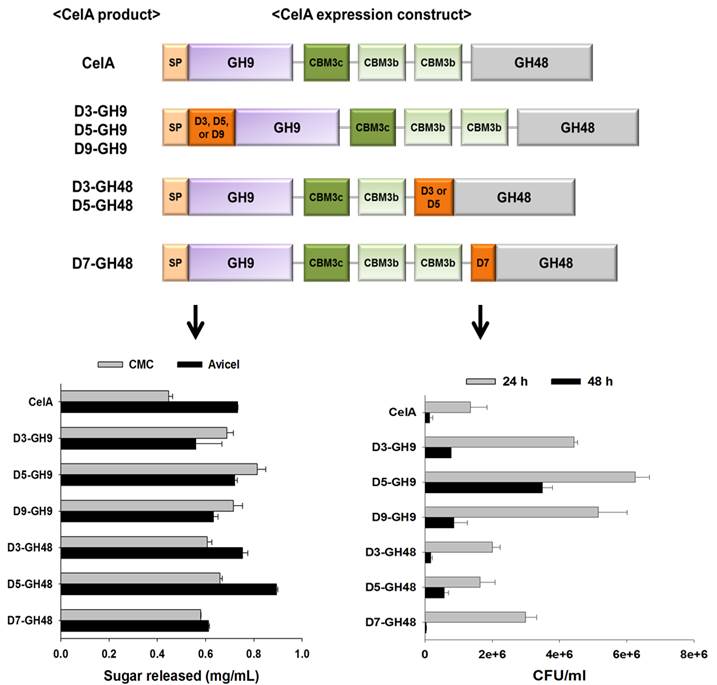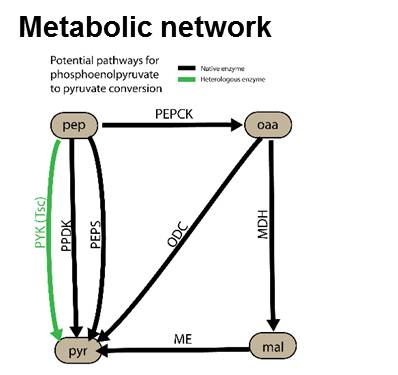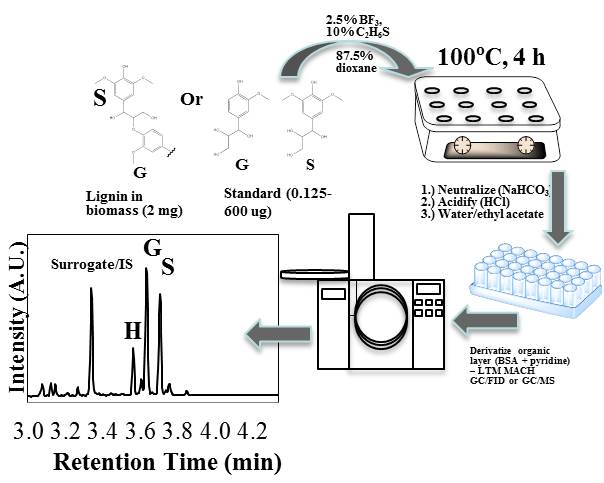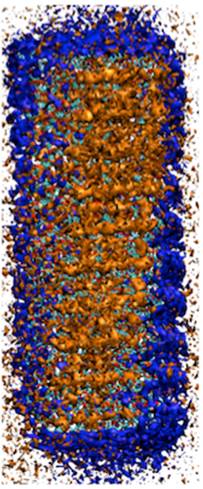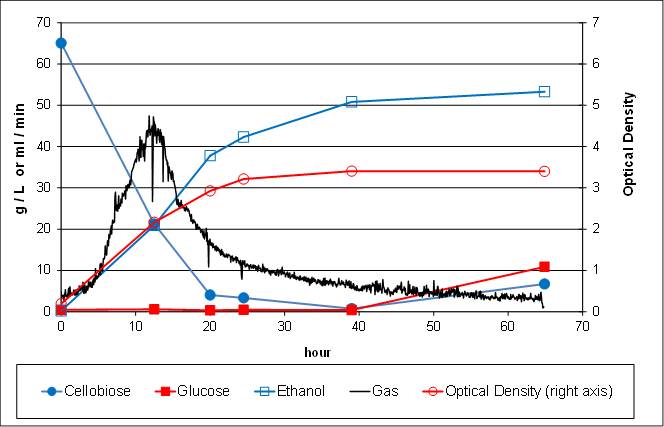
Biomass Formation and Modification

Enabling Technologies

Biomass Deconstruction and Conversion

-
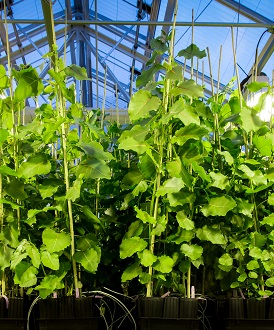
GWAS Dataset
Genome-Wide Association Study (GWAS) Dataset Released
The GWAS dataset comprises more than 28 million single nucleotide polymorphisms, or SNPs, derived from approximately 882 resequenced poplar genotypes. Each SNP represents a variation in a single DNA nucleotide, or building block, and can act as a biological marker, helping scientists locate genes associated with certain characteristics, conditions, or diseases. [Image courtesy ORNL]
Read More -

Natural Biocatalysts Outperform Industry Standard
Comparative study finds heat-loving microbes could reduce the need for thermochemical pretreatment
In the most comprehensive controlled comparison to date of lignocellulosic solubilization by various biocatalysts, BESC researchers found that naturally cellulolytic microbes such as Clostridium thermocellum (stained green and growing on poplar tissue in image) achieved significantly higher solubilization yields over commercial pretreatment systems. [Image courtesy ORNL]
Read More -
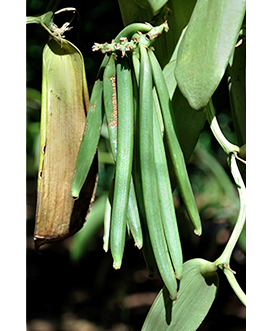
Promise of Unusual Lignin Polymer as Feedstock for Carbon Fiber
Stronger, Lighter Carbon Fiber Could Be Used in Parts for Cars, Aircraft, Electronics, and Sports Equipment
BESC researchers discovered an unusual lignin polymer in the seed coats of vanilla beans (pictured) that is naturally biosynthesized from caffeyl (C) alcohol. In contrast to lignin polymers that are highly cross-linked, C-lignin is a linear polymer, which makes it easier to process into high-quality carbon fibers. [Image courtesy iStock]
Read More -

Identification of Poplar Adaptation Mechanisms
Findings Could Lead to More Efficient Ways of Breeding High-Ethanol-Yielding Poplar and Other Tree Species
Using whole-genome sequencing and high-throughput phenotyping, BESC researchers were able to rapidly pinpoint gene mutations responsible for causing low lignin levels in poplar trees planted in a variety of environmental conditions. This proof-of-concept will allow researchers to tag genes associated with other economically important but complex plant traits. [Image courtesy BESC]
Read More -

Beneficial Plant Gene Discovery
Research Lays Groundwork for New Ways of Manipulating Plants
BESC researchers discovered a previously uncharacterized gene (GXMT1), which directs a key step in the development of xylan, a principal component of cell walls in plants such as Arabidopsis (pictured). Characterizing this gene, which makes the plant resistant to biofuel conversion, will lead to improved strategies for modifying such cell wall structures to help turn plants into biofuel more efficiently. [Image courtesy iStock]
Read More -

Molecular Structure of Plant Biomass
Imaging Reveals Enzymes in Action and Significance of Plants' Nanoscale Architecture
Plant cell walls contain networks of cellulose microfibrils that can be broken down into sugars for fuel and complex polymers that shield the cellulose from enzymatic attack. To characterize cell wall structure at the subnanometer scale and assess its response to chemical pretreatment, BESC developed techniques to image enzyme digestion in real time, revealing that biomass reactivity is determined by the nanoscale architecture of plant cell walls.
Read More -
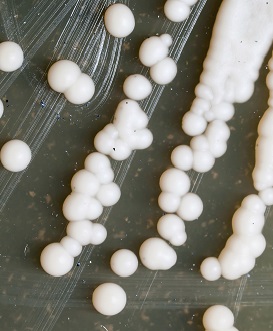
A Leap Forward in Microbial Ethanol Yields
Engineered yeast converts up to 97% of plant sugars into fuel
Scientists at BESC and research partner Mascoma LLC have developed an advanced strain of Saccharomyces cerevisiae that sets a new standard for conversion of biomass sugars from pretreated corn stover. While conventional yeast (pictured) leaves more than one-third of plant sugars unused in the form of xylose, the C5 FUEL™ microbe efficiently converts this xylose into ethanol in less than 48 hours.
Read More -

Real-World Performance of Low-Lignin Switchgrass
Field study assesses sugar release and ethanol yield in transgenic feedstock
Lignin in the cell walls of switchgrass and other bioenergy feedstocks severely limits the accessibility of cell wall carbohydrates to enzymatic breakdown into fermentable sugars and subsequently biofuels. In the first reported study of its kind, the biofuel potential of transgenic switchgrass with reduced lignin content was evaluated over two growing seasons.
Read More

-
Industry Collaborations
>Using a "commercialization council" of technology transfer and intellectual property (IP) management professionals from partner institutions, BESC evaluates the commercial potential of new inventions arising from BESC research and promotes and facilitates the licensing of BESC IP.

-
Education Outreach
>BESC's education program, which is 75% self-sustaining, takes a novel approach. BESC has developed lesson plans to educate students about energy production and utilization. BESC uses a hub-and-spoke approach of working through regional science centers to maximize hands-on access and adaptation to local conditions.

Progress to Date
January 10, 2017
Metabolic Adaptation Of C. thermocellum To Growth Inhibitors Released During Deconstruction Of Switchgrass
Integrated omics data of microbial growth on complex lignocellulosic biomass over time provided a detailed view of the molecular machinery (metabolites and enzymes) that reveals temporal adaptation to a complex, lignocellulose substrate — information that is critical for engineering C. thermocellum's industrial efficacy.
January 03, 2017
Engineering N-terminal End of CelA Enhances the Cellulolytic Activity of Caldicellulosiruptor bescii
To test whether alteration of the N-terminal terminus of CelA GH9 and CelA GH48 domains might improve secretion and/or catalytic efficiency of CelA, repeating aspartate tags were introduced into the N-terminal ends of these 8 domains. Introduction of repeating aspartate tags resulted in an increase in the general activity of the exoproteome and a dramatic increase in growth of C. bescii on crystalline cellulose. Most efficient cellulase systems contain highly active exocellulase enzymes capable of decrystallizing cellulose, so the observed increase in activity on Avicel bears directly upon the ability of CelA to degrade realistic biomass feedstocks destined for biofuels production.
December 22, 2016
Identification of LacI Repressor-Based Regulatory Network Activity Targeting Hemicellulases in C. thermocellum
Understanding C. thermocellum gene regulation is of importance for improved fundamental knowledge of this industrially relevant bacterium. We combined use of three lacI gene deletions with transcriptomics and DNA binding assays to gain insights into LacI regulatory networks. The identification of LacI repressor activity for hemicellulase gene expression is a key result of this work and will add to the small body of existing literature on the area of gene regulation in C. thermocellum.
December 12, 2016
Use Of Populus Natural Variants As A Research Tool To Further Determine Molecular Basis Of Recalcitrance
This project investigates the relative contributions of various factors to recalcitrance by a first-order multi-variants linear correlation analysis, which significantly helps improve the understanding of the fundamental mechanisms of biomass recalcitrance.
December 06, 2016
Confirmation of Role for Malate Shunt in Clostridium thermocellum Glycolysis
The unique metabolism of C. thermocellum has presented difficulties in engineering it for improved ethanol production. Improved understanding of the malate shunt will allow the design of strains for improved ethanol production.
November 29, 2016

In situ 3D SRS imaging to track xylan distribution in deacetylated corn stover cell wall before and after xylan digestion
New Approach Allows Resolution Of Xylan Polymers In Plant Cell Wall
This approach demonstrated that xylan, an important plant polymer source, can be resolved from cellulose and lignin in situ using enzymatic digestion and label-free SRS microscopy. This can be used to enhance understanding of xylan in cell wall biosynthesis and deconstruction.
November 21, 2016
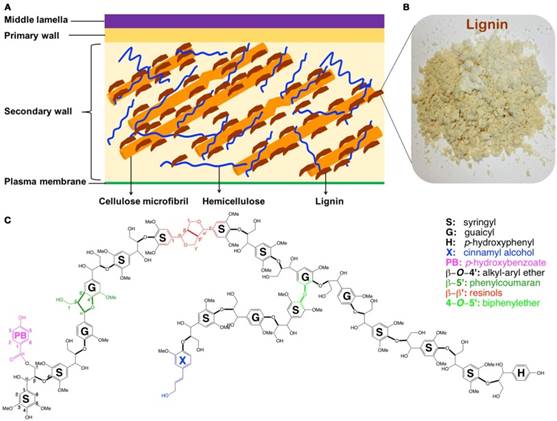
Simplified structure of plant cell walls (A), lignin isolated from poplar (B), and schematic structure of poplar lignin (C)
Mini Review Surveys Improvements In Understanding Relationship Of Lignin Structure To Biomass Recalcitrance
This review focuses on advances in understanding the specific roles of lignin properties during pre-treatment;
lignin-enzyme interactions; monolignol compositional units; and hydroxycinnamates and hydroxyl and carboxylic groups in lignin.
November 03, 2016

Comparisons of five transgenic switchgrass lines to their parental controls (* indicates not a stati (...more)
Comparative Analysis Of Field-Grown Transgenic Switchgrass Lines Shows Stable Increases In Biofuel Yields
Clones of plants representing independent transgenic events and their respective non-transgenic control lines were investigated for biomass yield, carbohydrate composition, and recalcitrance to bioconversion via separate hydrolysis and fermentation to ethanol. Over two consecutive field-growth seasons, most transgenic lines maintain higher glucan and xylan yield at similar, or sometimes better, plant biomass. Transgenic lines targeting cell wall modifications yielded significantly higher bioconversion to ethanol (up to 36% and 21% in year 1 and year 2, respectively).
November 02, 2016
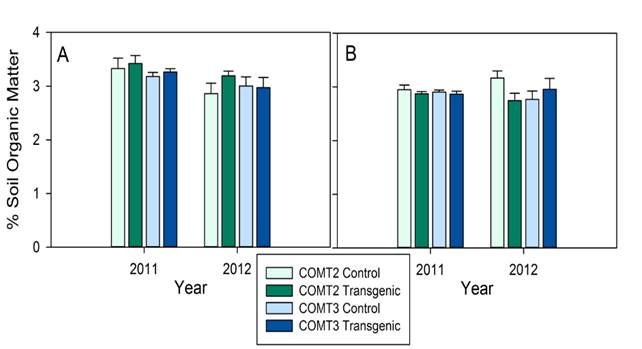
Mean soil organic matter in the upper 0-15 cm (A) and deeper 15-30 cm (B) during the first two growi (...more)
Field Grown Transgenic Switchgrass Has No Negative Affect On Soil Chemistry, Microbiology Or Carbon Storage Potential
BESC has demonstrated that when shoot S/G lignin ratio is decreased in switchgrass, greater yields of biofuel can be produced; understanding agronomic consequences of such changes is important to proving industrial value of engineered biofuel crops. COMT-altered switchgrass appears to be substantially equivalent to non-engineered switchgrass with regards to soil and microbiome properties.
November 01, 2016
Engineering Electron Metabolism to Increase Biofuel Production in Clostridium thermocellum
Engineering electron metabolism is a promising strategy for improving ethanol production in C. thermocellum. A strain with improved ethanol production was also generated by overexpressing the rnfCDGEAB operon.
November 01, 2016

Heat map of C. thermocellum transcriptomic response to exogenous acetate. Blue and yellow ind (...more)
Improving Robustness of Engineered C. thermocellum
Understanding and overcoming low robustness in engineered microorganisms will be essential to industrial deployment of these organisms. This study helps reveal mechanisms of electron balancing in C. thermocellum that leads to increased robustness in its potential use in biofuel production.
October 28, 2016
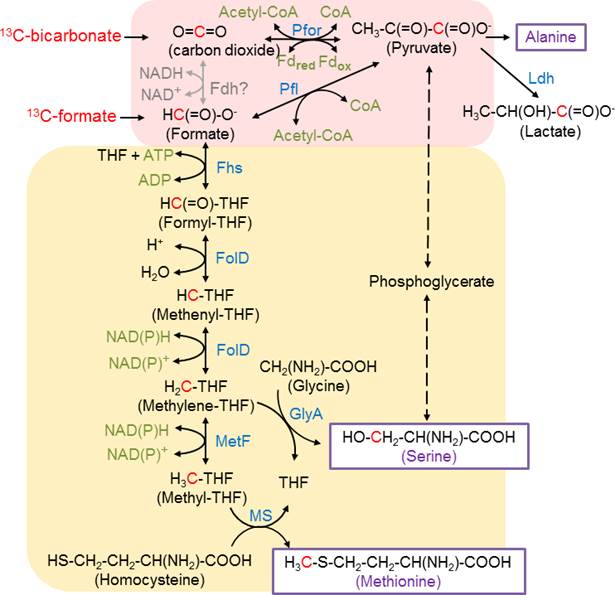
Schematic of reductive C1 metabolism initiated from reversed PFOR and PFL. Carbons in red indicate < (...more)
C. thermocellum Endowed with Ability to Fix CO2
A novel route that C. thermocellum employs to fix CO2 when grown in primarily heterotrophic mode supplemented with sodium bicarbonate was discovered. Critical enzymes responsible for fixing CO2 and channeling the fixed carbon to the C1 metabolic pathway were identified. This research paves the way to future engineering of the Clostridium thermocellum bacterium to utilize cellulose and CO2 simultaneously as a means to improve microbial carbon efficiency and reduce CO2 in the environment.
October 19, 2016
National Bioenergy Day
BESC participated with seven different agencies to provide educational and informative biofuel connected activities and displays for ~200 elementary children during the National Bioenergy Day celebration held at the University of Tennessee (UT) Arboretum in Oak Ridge, Tennessee.
September 30, 2016

GreenWood and ORNL Sign Agreement.
Seated: Brian Stanton, Chief Science Officer, GreenWood Resour (...more)
GreenWood Resources Licenses BESC Invention to Boost Biofuel Yield
GreenWood Resources has licensed a BESC technology based on the discovery of a gene in Populus trichocarpa that makes it easier to convert poplar trees into biofuels. They plan to commercialize the technology to select and breed better varieties of poplar with less lignin content, which simplifies the conversion process and ultimately lowers the overall costs of biofuel production.
September 15, 2016
New Thioacidolysis Method Allows for Improved Throughput in Linking Biomass Recalcitrance with Lignin Structure and Composition
Thioacidolysis is a method used to measure the relative content of coumaryl (H), syringyl (S) and coniferyl (G) alcohol lignin monomers bound by β-O-4 linkages. This new method was developed with significantly higher throughput than traditional techniques and was found to measure statistically similar S/G ratios in lignin from different lignocellulosic biomass types relative to a traditional low-throughput technique. The composition and structure of lignin based on the relative amount of monomers bound by β-O-4 linkages can be more rapidly determined for screening purposes allowing for improved throughput in linking biomass recalcitrance with lignin structure and composition.
September 06, 2016
Development Of A Genome-Scale Metabolic Model Of C. Thermocellum Assists In Strain Design For Biofuels And Chemicals
Genome scale modeling is a powerful tool for investigating cellular metabolism. A genome scale model (GEM) of DSM 1313 was constructed and curated for simulation of growth on alternative cellulosic substrates by implementing an adjustable cellulosome. Using the GEM, researchers were able to explore how key redox and bioenergetic reactions change as a function of growth rates and carbon sources in a systematic manner. Use of the model led to a proposed substrate-dependent regulatory mechanism by which ethanol production is enhanced or limited.
August 25, 2016
Heterologous Expression of Xylanases from A. cellulolyticus Enhances Hemicellulolytic Activity of C. bescii
To test whether the addition of A. cellulolyticus xylanases might enhance the hemicellulolytic activity of C. bescii and growth on xylan substrates, the xylanases were expressed in C. bescii using new expression vectors. Expression of the xylanases in C. bescii results in an increase in the activity of the exoproteome on xylan and a dramatic increase in its ability to grow on xylan substrates.
August 10, 2016
Microbial Upgrading of Lignin-Derived Carboxylates to Branched-Chain Esters for Drop-in Biofuels
An innovative biological conversion route was developed for conversion of lignocellulosic biomass or organic wastes into biofuels and high-value chemicals.
August 08, 2016
HPC Simulation of Co-Solvent Pretreatment of Biomass Confirmed by Experiment
Previous BESC work has shown that reaction of biomass in aqueous tetrahydrofuran (THF) in CELF (Co-solvent Enhanced Lignocellulosic Fractionation) pretreatment is highly effective at delignification and deconstruction of biomass for biofuels and bioproducts. Molecular dynamics simulations were performed of whole cellulose fibers and single cellulose chains in a THF-water co-solvent at various temperatures on the ORNL TITAN supercomputer. The simulations were complemented by THF-water experiments on cellulose, measuring its solubilization and imaging the product residue.
August 05, 2016
Creative Discovery Museum Receives Pinnacle Award for Distance Learning
The Creative Discovery Museum (CDM) has been awarded a Center for Interactive Learning and Collaboration (CILC) Pinnacle Award for 2015 – 2016 based on recipient evaluations. The BESC-sponsored CDM "Distance Learning Biofuels" program is a 50-minute lesson designed for students in grades 4 – 8. A museum educator from CDM provides the lesson via video conferencing. The program provides the opportunity for students to learn about innovative research taking place in the fields of biofuels and alternative energy.
July 27, 2016
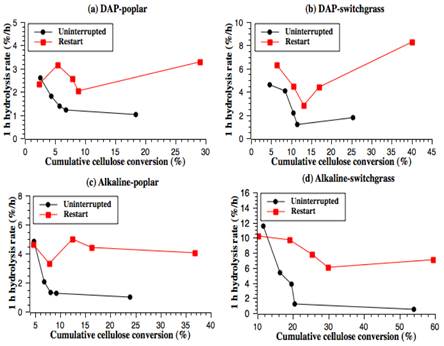
One-hour hydrolysis rate versus cumulative cellulose conversion for uninterrupted and restarted hydr (...more)
Cellulose DP And Accessibility Contribute To Cellulase Enzyme Action On Biomass Substrate
The enzymatic hydrolysis of lignocellulosic biomass proceeds initially at a fast rate followed by a rapid decrease in the conversion rates. Degree of polymerization (DP) analysis during hydrolysis suggested a synergistic action of endo- and exo-glucanases that contribute to the occurrence of a peeling off mechanism. Cellulose accessibility analysis showed that limited accessible surface area of cellulose is probably not a major limiting factor that causes the decline of hydrolysis rate in its late stage. Restart hydrolysis experiment suggested that enzyme related factors such as enzyme inactivation or steric hindrance of enzymes should be responsible to the reduction in hydrolysis rate given the large size of cellulase enzymes.
June 21, 2016

Dr. Liao received his Bachelor degree at the National Taiwan University and his Doctorate at the University of Wisconsin-Madison
James Liao Appointed To Serve As Academia Sinica President
Dr. James Liao has been named as the 11th president of Academia Sinica — the top academic research institution in Taiwan. Academia Sinica supports research activities in a wide variety of disciplines, ranging from mathematical and physical sciences, to life sciences and to humanities and social sciences. Dr. Liao serves as the BESC Activity Lead for Butanol Production by CBP.
June 20, 2016
Discovery Of A Novel Molecular Mechanism Controlling Seed Physical Dormancy
Physical seed dormancy exists widely in higher plants, but its molecular mechanism has remained largely elusive. By screening a large number of Tnt1 retrotransposon-tagged Medicago truncatula lines, we identified non-dormant seed mutants from this model legume species. This study elucidated a novel molecular mechanism of physical dormancy and revealed a new role of class II KNOX genes.
June 20, 2016
Syringyl/Guaiacyl (S/G) Ratio In Lignin May Influence Quality Of Carbon Fiber Produced From Lignins
Current lignin-based carbon fiber using low-cost lignin precursors does not possess the mechanical properties required for many structural applications. Lignins with various syringyl/guaiacyl (S/G) ratios were isolated from Populus genotypes and subjected to rheological treatment at various temperatures and cooling conditions. Organosolv lignins extracted from genotypes with lower S/G ratios exhibited higher viscosity values and molecular weights with larger amounts of condensed structures following rheology treatment at relatively lower temperature; higher viscosity and molecular weight is known to provide for higher quality carbon fiber.
June 20, 2016
Improved Thermophilic Anaerobe Achieves High Biofuel Titers From Wood And Cellulose
This study demonstrates that thermophilic anaerobes are capable of producing ethanol at high yield and at titers greater than 60 g/L from purified substrates. However,challenges were encountered with existing fungal cellulases and inhibitors from pretreatment. The high titers and yields observed support the feasibility of using engineered thermophiles for industrial ethanol production if challenges associated with pretreatment inhibitors can be avoided.
June 07, 2016
Simultaneous Achievement Of High Ethanol Yield And Titer In Clostridium thermocellum
Adaptive evolution successfully improved the ethanol yield and the titer from a rationally engineered CBP strain. This evolved strain has the highest ethanol yield and titer reported to date for C. thermocellum, and is an important step in the development of this microbe for industrial applications.
June 01, 2016
Workshop Summary: Lessons From Industry In Commercializing Biotechnology
This article summarizes lessons learned drawn from the "Technology Challenges and Opportunities in Commercializing Industrial Biotechnology Workshop," September 28-29, 2015, San Diego.
| Publication Date | Citation DOI |
|---|



